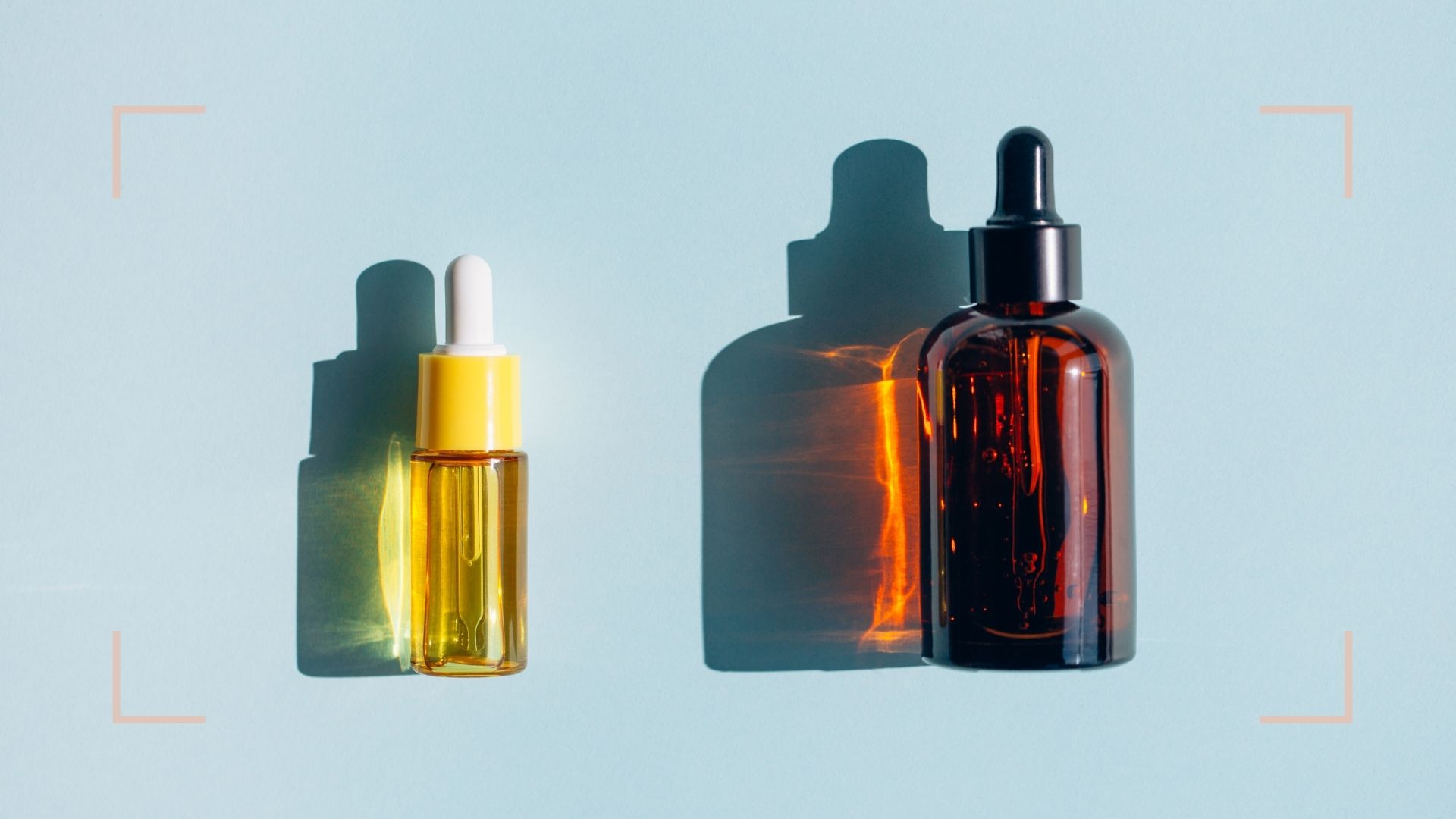Glycolic acid vs retinol: benefits, differences, and how to use each
How to decide between glycolic acid vs retinol in your skincare routine


Debating whether you should use glycolic acid vs retinol? There’s a lot of buzz around these skincare ingredients and both can achieve excellent results. But how do you know whether glycolic acid or retinol is the right choice for your own personal needs and skin goals?
Retinol and glycolic acid are two of the most powerful active ingredients available in topical skincare. They are beloved by beauty editors and dermatologists alike and widely considered superstars of the modern skincare routine. But, due to their potency, these skincare ingredients should be carefully considered before you try them, to work out if either—or both—will agree with you.
To help you settle the glycolic acid vs retinol debate once and for all, we've gathered expert opinions on both to find out what they actually do for your skin and how to use them effectively to get the best results.
Glycolic acid vs retinol: Your expert guide
What are glycolic acid and retinol?
What is glycolic acid?
"Glycolic acid is an alpha hydroxy acid (AHA) with the smallest molecular weight of them all,” says David Petrillo, cosmetic chemist and founder of Perfect Image. “It helps gently dissolve bonds between the cells, exfoliating skin cells off the epidermal layer.”
Derived from sugar cane, this skincare acid is included in many of the best facial exfoliators. Once it breaks down those bonds on the surface of your skin, it helps you shed the dead, dull and discolored skin cells that contribute to the appearance of aging. This process promotes cellular renewal, meaning newer and more youthful-looking skin cells are produced and revealed to fade pigmentation, shift dullness, and soften fine lines. “The result is that the skin looks smoother and any sunspots will have been lightened," explains Jose Mier, founder of Heliotherapy Research Institute.
What is retinol?
Retinol comes in many forms but all are derivatives of Vitamin A (so if you were weighing up retinoid vs retinol, they are derived from the same source) It has multifaceted benefits, which mostly come down to cell turnover improvements. “Retinol gets deep into the layers of the skin, pushing forward production of collagen and elastin—the proteins that contribute to skin elasticity,” Jose explains. “It also promotes skin cell rebuilding and helps to improve a person’s skin tone.”
In terms of visible effects, retinol is a versatile ingredient that helps contribute to brighter, bouncier skin and a more even complexion. Due to its texture improving abilities it is excellent for those who want to know how to get rid of acne scars and is also regularly used in a skincare routine for acne due to its ability to speed up cell shedding and shift congestion.
Sign up for the woman&home newsletter
Sign up to our free daily email for the latest royal and entertainment news, interesting opinion, expert advice on styling and beauty trends, and no-nonsense guides to the health and wellness questions you want answered.
What do glycolic acid and retinol have in common?
Deciding between glycolic acid vs retinol starts with recognizing their similarities. You’ll see both glycolic acid and retinol in products designed to promote a youthful-looking skin texture. That’s because, although they work differently, they both essentially exfoliate—either from within, in the case of retinol, or externally in the case of glycolic acid.
“Benefits of retinol and glycolic acid include promoting collagen production, increasing cell turnover, gently exfoliating dead skin cells, reducing fine lines and wrinkles, lightening hyperpigmentation, and treating acne," explains Petrillo.
Glycolic acid vs retinol The key differences
While they share many benefits, the main difference between glycolic acid vs retinol is how they work to create that younger-looking, glowing complexion.
- Depth: “Glycolic acid only penetrates and exfoliates dead skin cells on the skin's surface, while retinol works on the deeper level of the skin's dermis to increase blood flow and reorganize the cell structures.” says David.
- Elasticity: Retinol’s top concern is getting those deeper layers of skin in shape for improved elasticity and collagen production, which in turn leads to fewer fine lines and wrinkles.
- Cell-shedding: The main task on glycolic acid’s to-do list is top-level exfoliation. It’s a reliable ingredient for helping slough off old skin cells to reveal those lovely fresh layers beneath the surface.
How to use glycolic acid and retinol

If you're shopping for skincare and weighing up glycolic acid vs retinol, you’ll see both featured in a variety of the best skincare products, usually designed to be used in a skincare night routine. As with any active ingredient, both can cause irritation if not used properly, so bear in mind a few protocols:
- Pick the right products: Glycolic acid generally comes in pre-soaked pads or some of the best toners for exfoliation, this makes it easy to swipe over the skin's surface. With retinol, look for products in tinted glass droppers or airless pumps as it can be destabilized by light and air.
- Start slow: In both instances, start with a patch test then use a low concentration of the ingredient a few nights a week to see how your skin responds.
- Wait until the evening: Save glycolic acid and retinol for your nighttime routine, this will make the most of your overnight cell renewal process and ensure you don't expose freshly exfoliated cells to UV damage during the day.
- Alternate which one you’re using: Switch between glycolic acid vs retinol on different nights if you want to keep both in your routine. Using both together could overstimulate the skin.
- Follow up with moisturizer: After your glycolic acid or retinol treatment, hydrate your skin and ward off any dryness or irritation with the best face moisturizer for your skin.
- Apply SPF the next day: Use a broad-spectrum sunscreen to protect your freshly-revealed skin after using these exfoliating ingredients.
When shouldn't I use these ingredients?
Women who are pregnant or breastfeeding are not recommended to use retinol. Otherwise, these ingredients make a great addition to most routines, as long as you use them carefully. “More is more” doesn’t work when you’re trying to rejuvenate mature skin. First and foremost, you shouldn’t use retinol and glycolic acid in combination with each other," advises Jose.
“At first glance, it might seem like these two are perfectly combined: Glycolic acid breaks down dead skin cells, while retinol contributes to cell rebuilding. However, this is not the case,” advises Jose. “Both are active ingredients and, when used together, can cause dry skin and irritations.” David adds that retinol shouldn’t be mixed with Vitamin C (aka ascorbic acid) in the same application either, “because they work best in different pH environments for skin absorption.”
Glycolic acid vs retinol: w&h verdict
The debate of glycolic acid vs retinol boils down to the two skincare powerhouses coming up against each other and discovering that, actually, there's no need to fight. Both encourage fresh skin texture, promote collagen, and help reveal a bright, even skin tone. While glycolic acid offers a more bang for your buck in terms of an instant glow and smoothness, retinol works from within so is more of a long game (expect results in 12 weeks) but those lasting texture improvements are worth waiting for.
The best news is, there is no need to choose between these two ingredients at all, they can work in harmony in the same routine, providing you don't have particularly sensitive skin, you introduce them slowly and use them with care.
woman&home thanks David Petrillo of Perfect Image and Jose Mier of Heliotherapy Research Institute, for their time and expertise

As woman&home's Beauty Channel Editor, Fiona Mckim loves to share her 15+ years of industry intel on womanandhome.com and Instagram (@fionamckim if you like hair experiments and cute shih-tzus). After interning at ELLE, Fiona joined woman&home as Assistant Beauty Editor in 2013 under industry legend Jo GB, who taught her to understand ingredients and take a cynical approach to marketing claims. She has since covered every corner of the industry, interviewing dermatologists and celebrities from Davina McCall to Dame Joan Collins, reporting backstage at London Fashion Week and judging the w&h Beauty Awards.
-
 Need spring style inspiration? Jennifer Aniston proves a shirt dress is the most versatile item you can invest in
Need spring style inspiration? Jennifer Aniston proves a shirt dress is the most versatile item you can invest inIf you only buy one piece this weekend, make it a shirt dress
By Matilda Stanley Published
-
 Celebrities you never knew got their start as models, from Angelina Jolie's 'terrible' experience to A-listers who started as pageant queens
Celebrities you never knew got their start as models, from Angelina Jolie's 'terrible' experience to A-listers who started as pageant queensWhether it was just for a short time or it's how they got discovered for something else, these stars owe it all to striking a pose
By Jack Slater Published